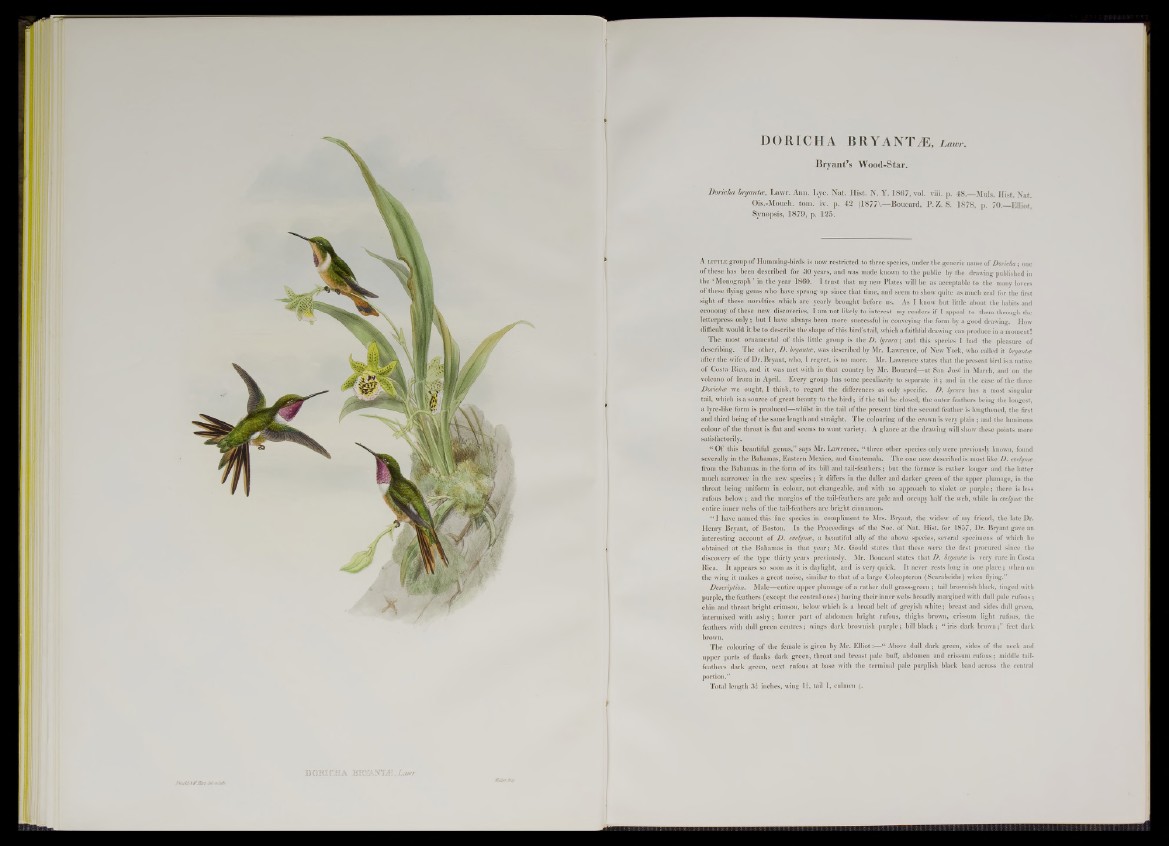
BORICHA BKYANVÆ,Lcuvr
JOauU/kWEoh Maiith/
DORICHA BRYANTÆ, Lawr.
Bryant’s Wood-Star.
Don ch a bryantee, Lawr. Ann. Lyc. N a t. H ist. N . Y. 1 8 6 7 , vol. viii. p. 4 8 .— Muls. Hist. Nat.
Ois.-Mouch. tom. iv. p. 4 2 (18771— Boucard, P. Z. S. 1 8 7 8 , p. 70. Elliot,
Synopsis, 1 8 7 9 , p. 125.
A l i t t l e group of Humming-birds is now restricted to three species, under the generic name of Doncha ; one
of these has been described for 30 years, and was made known to the public by the drawing published in
the ‘ Monograph ’ in the year 1860. I trust that my new Plates will be as acceptable to the many lovers
of these flying gems who have sprung up since that time, and seem to show quite as much zeal for the first
sight o f these novelties which are yearly brought before us. As I know but little about the habits and
economy of these new discoveries, I am not likely to interest my readers if I appeal to them through the
letterpress only ; but I have always been more successful in conveying the form by a good drawing. How
difficult would it be to describe the shape of this bird’s tail, which a faithful drawing can produce in a moment!
The most ornamental of this little group is the D . lyrura ; and. this species I had the pleasure of
describing. The other, D. bryantee, was described by Mr. Lawrence, of New York, who called it bryantee
after the wife of Dr. Bryant, who, I regret, is no more. Mr. Lawrence states that the present bird is a native
o f Costa Rica, and it was met with in that country by Mr. Boucard—at San José in March, and on the
volcano of Irazu in April. Every group has some peculiarity to separate it ; and in the case of the three
Dorichee we ought, I think, to regard the differences as only specific. D. lyrura has a most singular
tail, which is a source of great beauty to the bird ; if the tail be closed, the outer feathers being the longest,
a lyre-like form is produced— whilst in the tail of the present bird the second feather is lengthened, the first
and third being of the same length and straight. The colouring o f the crown is very plain ; and the luminous
colour o f the throat is flat and seems to want variety. A glance at the drawing will show these points more
satisfactorily.
“ O f this beautiful genus,” says Mr. Lawrence, “ three other species only were previously known, found
severally in the Bahamas, Eastern Mexico, aud Guatemala. The one now described is most like D. evelynee
from the Bahamas in the form of its bill and tail-feathers ; but the former is rather longer and the latter
much narrower ¡u the new species ; it differs in the duller and darker green of the upper plumage, in the
throat being uniform in colour, not changeable, and with no approach to violet or purple ; there is less
rufous below ; and the margins of the tail-feathers are pale and occupy half the web, while in evelynee the
entire inner webs of the tail-feathers are bright cinnamon.
“ I have named this fine species in compliment to Mrs. Bryant, the widow of my friend, the late Dr.
Henry Bryant, o f Boston. In the Proceedings of the Soc. of Nat. Hist, for 1857, Dr. Bryant gave an
interesting account of D . evelynee, a beautiful ally of the above species, several specimens o f which he
obtained at the Bahamas .in that year; Mr. Gould states that these were the first procured since the
discovery o f the type thirty years previously. Mr. Boucard states that D. bryantee is very rare in Costa
Rica. It appears so soon as it is daylight, and is very quick. It never rests long in one place ; when on
the wing it makes a great noise, similar to that o f a large Coleopteron (Scarabeidse) when flying.”
Description. Male— entire upper plumage o f a rather dull grass-green ; tail brownish black, tinged with
purple, the feathers (except the central ones) having their inner webs broadly margined with dull pale rufous ;
chin and throat bright crimson, below which is a broad belt of greyish white ; breast and sides dull green,
intermixed with ashy ; lower part o f abdomen bright rufous, thighs brown, crissum light rufous, the
feathers with dull green centres ; wings dark brownish purple ; bill black ; “ iris dark brown ;” feet dark
brown.
The colouring of the female is given by Mr. Elliot :—“ Above dull dark green, sides o f the neck and
upper parts of flanks dark green, throat and breast pale buff, abdomen and crissum rufous ; middle tail-
feathers dark green, next rufous at base with the terminal pale purplish black band across the central
portion.”
Total length 3è inches, wing If, tail 1, culmen